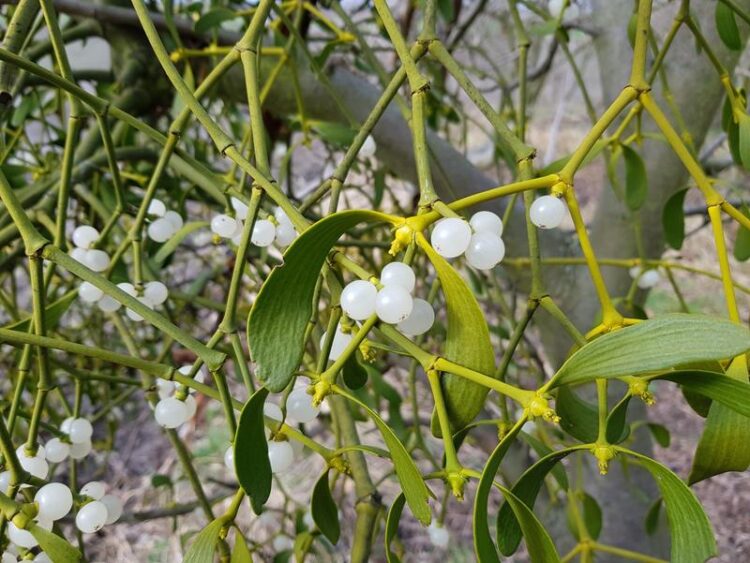Natural super glue from native mistletoe berries

Close up of mistletoe berries
(c) Nils Horbelt / Max Planck Institute of Colloids and Interfaces
– a promising discovery.
A team of researchers from the Max Planck Institute of Colloids and Interfaces (MPICI) and McGill University in Canada discovered strong adhesive properties of white-berry mistletoe.
The mistletoe berry’s flexible fibers adhere to both skin and cartilage as well as to various synthetic materials and could find application in many fields, such as wound sealant in biomedicine, through ease of processing.
For their research, the materials scientists led by Prof. Dr. Peter Fratzl picked the mistletoe berries from the trees themselves. From his office window, the director of the Department of Biomaterials can see the many green parasitic plants. “Mistletoe grows in large numbers everywhere, including the Max Planck Campus, and is biodegradable and renewable,” says Peter Fratzl, adding, “For the first time, we are now investigating how to harness its excellent adhesive properties for potentially medical or technical uses.”
Advantages of the biological glue: it adheres very well and is easy to remove under humid conditions.
To observe the adhesive properties, materials scientist and former carpenter Dr. Nils Horbelt wore the mistletoe glue on his fingers for three days in a self-experiment: “Afterwards, I was able to remove the viscin by simply rubbing my fingers together.” Each mistletoe berry can produce a sticky thread up to two meters long called viscin – a natural cellulose adhesive. This allows the seeds of the semi-parasitic plant to stick to their host plants.
The researchers in the former research group of Dr. Matthew Harrington, who has since moved on to a professorship at McGill University in Canada, discovered that viscin fibers can be stretched into thin films or assembled into 3D structures by simply processing them when wet.
This natural super glue could potentially find application as a wound sealant, and it also adheres to metals, glass and plastics. Also exciting is the fact that the adhesive properties are fully reversible under humid conditions.
“Many questions remain about this very unusual material,” says Nils Horbelt, first author of the present study. The next step will now be to investigate the chemistry behind this swellable, extremely sticky material in order to be able to imitate the bonding process in a second step.
Originalpublikation:
Horbelt, N., Fratzl, P. and Harrington, M.J. Mistletoe viscin: A hygro- and mechano-responsive cellulose-based adhesive for diverse materials applications. (2022) PNAS Nexus. 1, pgac026. https://doi.org/10.1093/pnasnexus/pgac026
Weitere Informationen:
https://www.mpikg.mpg.de/biomaterials
https://www.mpikg.mpg.de/press-releases
Media Contact
All latest news from the category: Materials Sciences
Materials management deals with the research, development, manufacturing and processing of raw and industrial materials. Key aspects here are biological and medical issues, which play an increasingly important role in this field.
innovations-report offers in-depth articles related to the development and application of materials and the structure and properties of new materials.
Newest articles

Innovative 3D printed scaffolds offer new hope for bone healing
Researchers at the Institute for Bioengineering of Catalonia have developed novel 3D printed PLA-CaP scaffolds that promote blood vessel formation, ensuring better healing and regeneration of bone tissue. Bone is…

The surprising role of gut infection in Alzheimer’s disease
ASU- and Banner Alzheimer’s Institute-led study implicates link between a common virus and the disease, which travels from the gut to the brain and may be a target for antiviral…

Molecular gardening: New enzymes discovered for protein modification pruning
How deubiquitinases USP53 and USP54 cleave long polyubiquitin chains and how the former is linked to liver disease in children. Deubiquitinases (DUBs) are enzymes used by cells to trim protein…



